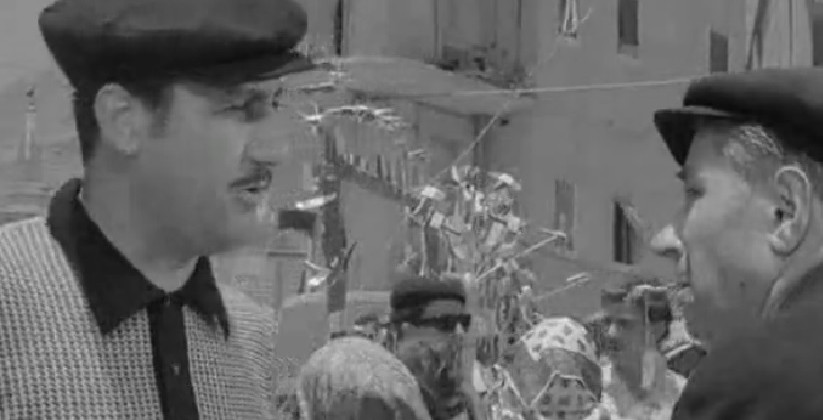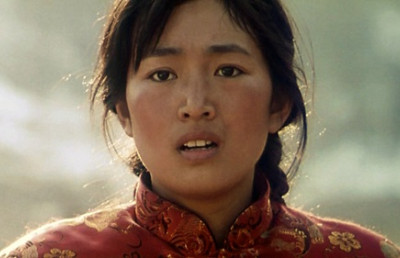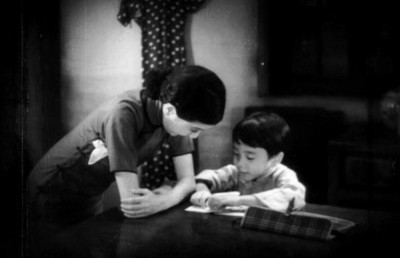Alberto Lattuada
At La Cinémathèque québécoise

Photo: Header photo & thumbnail sourced from Criterion DVD
As part of their April-May program la Cinémathèque québécoise featured a mini-retrospective of one of Italy’s oldest living directors, Alberto Lattuada (born, 1914). The nine films selected span a good portion of Lattuada’s long career, the earliest being Il Bandito (1946), and the latest Sono stato io! (1973). Lattuada’s last film being Sarafina (1992). In Sono stato io! tragi-comic actor extraordinaire Giancarlo Giannini takes a break from regular co-worker Lina Wertmuller to play a like-minded little guy with over aspirations. Puppy-eyed Giannini plays a window cleaner at day and an opera extra at night. As a worker Giannini spends most of his time high above the Milanese cityscape, peeking into slick high finance offices and fantasizing himself in role reversals. One such fantasy sees Giannini inside one of the Tati-esque modernist offices flanked by two gorgeous bikini-clad secretaries. Another running fantasy takes place at the opera wear he works and involves the statuesque opera diva that Giannini lusts over. Unhappy as a lowly worker, the Giannini character craves fame and fortune. So much so that when the diva is found strangled to death in her backstage room Giannini sneaks into the room to leave behind incriminating clues. (fingerprints, a coat button, etc.). Unfortunately, he is such a sap that the police can not envision him as the killer, even when everything obviously points to him (no doubt this is also a satirical poke at the Italian police). Giannini finally gets his wish and is arrested after staging a murder attempt where he apes the exact style of the original murder, in effect framing himself. The film’s penultimate scene is his murder trial, a scene somewhat reminiscent of the courtroom scenes in Seven Beauties . Giannini acts confidently throughout the murder trial because he has an ace up his sleeve: a sure-fire alibi. Giannini’s lawyer calls to the stand an elderly man, an ex-police chief and decorated war officer who will attest that, indeed, Giannini was with him the night of the murder. Just as he is about to speak his testimony he has a heart attack and dies! In an ironic conclusion, Giannini ends up in jail without the notoriety he so exhaustively planned.
After seeing six of the nine films one thing that struck me about Lattuada’s style is the importance of architecture, in both a literal and figurative sense. Hence I wouldn’t be surprised if Giannini’s physical position as a window cleaner high above the city is a meant as a visual pun standing in for his character (“his head in the clouds”). In most of the films the central narrative drive stems from a character’s wish to change or transform themselve. In four cases the drive for change is self-directed by the character. Along with Giannini in Sono stato io! there is Carla Del Poggio (Lattuada’s then wife) in Luci dei varietà (1950, co-directed with Federico Fellini), as a young girl from a provincial town with aspirations of becoming a famous theatre star. In Il cappotto (based on the Gogel novel, 1952) there is the petty office clerk Del Carmine (wonderfully played by comic actor Renato Rascal) who pines for a new coat that he feels will give him the social status he so slavishly covets. And in La spiaggia (1954) Martine Carol plays a prostitute who vacations on the Riviera with her daughter in an attempt to start life anew. Only in Il mafioso is the change imposed from without, with Alberto Sordi, a transplanted Sicilian now living as a full-fledged industrial bourgeois in Milan, constrained by his past affiliations to commit a potentially life-changing act: murder.
Il mafioso is exemplary of Lattuada’s ability to mix genres and deftly switch tones from comedy (satire, irony, and parody) to drama. Sordi, a foreman at a Milan car plant, is ecstatic in anticipation of his visit to his hometown in Sicily, where he will introduce his wife and two children to his family. The sequence where he first meets his family is vintage Italian comedy. Sordi is overwhelmed with tears of joy, slipping easily from proper northern Italian to his rural town dialect as he makes his way from sibling to father to aunt and, lastly of course, mother. Lattuada underscores the melodramatic hysteria by shooting the sequence (mainly) in a close-up long take. Lattuada slips easily from such moments of high comedy to the mounting tension in the sequence where he is blindly flown to New York where he must perform the duties of a professional killer to repay his debt to the community godfather Don Vicenzo. This whole extended sequence is one of the highlights of the film and demonstrates Lattuada’s excellent use of architecture and mise-en-scene to portray the scene’s emotional core. As his hometown visit progresses it becomes evident that Sordi is being groomed by the mafia to kill a rival Don in New York city. Don Vicenzo, who has already sown the seed of duty by setting Sordi up in his Milan job, tightens the noose by resolving a land dispute in Sordi’s favor. With the deck stacked, the Don asks Sordi for a simple favor, one that he obviously can not refuse: hand deliver a letter to someone. To shield the incident from Sordi’s wife and children, a ruse is set: Sordi is leaving on a two-day hunting trip. Everyone else in the town seems to know what is really transpiring, but the law of “omerta” prevails (the conspiracy of silence in the criminal underworld). Even Sordi seems oblivious to what is happening.
Lattuada’s ability to play humor off the tension is in evidence when on the morning of the hunting trip, Sordi’s father hugs his son as if he were going off to war. Lattuada expresses the power and sway the mafia have on Sordi, and by extension the whole community, with a mise-en-scene that gets progressively claustrophobic. The passing on of the ruse letter occurs in the crowded back seat of a car. The “hunting” trip begins with Sordi’s early morning walk through the town’s desolate, dimly lit narrow streets to his meeting place. The next series of locations play on this notion of the mafia’s social and cultural stranglehold. Sordi moves from crowded car, to the back of a stocked truck, to an airmail shipping crate (where he spends the whole Sicily to New York flight), to a crowded car in New York, to a cramped elevator lift that brings him to a small hotel room where he is shown home movie footage of the person he is to assassinate.
In Il Cappotto the poor Del Carmine pines after a new coat that he feels will enable him to walk with dignity and mingle with the middle class. He also feels that with the new coat he will be able to date the lovely woman who lives across the courtyard from him. But Del Carmine does not realize that she is the plaything-lover of the adulterous, vain mayor (a theme Lattuada will explore in La Spiaggia ). This kept woman links Del Carmine to the villain of the piece, the mayor. He finally commits all his savings to a custom-made coat, but social progress is more that material gain. Preening about in his coveted coat, Del Carmine appears ludicrous because he lacks the inner self to match the exterior pomposity. The contrast recalls Henri Bergson’s famous views on comedy, and his central metaphorical comic image of “the mechanical encrusted upon the living.” Comedy serves as a corrective social gest to remind us of Del Carmine’s social status. Lattuada also employs verbal humor in two particular scenes where Del Carmine is asked to make a speech in the presence of the mayor and somehow manages to reduce the event to a ludicrous shamble by inverting its meaning and context. (This form of verbal humor is a favorite of contemporary Italian comic Roberto Benigni, who uses it in Johnny Stecchino and La vita e bella .)
As in Il Mafioso , Lattuada uses architecture symbolically in Il Cappotto by having the physical environment reflect the overwhelming psychological and social hold of the middle class over the poor. This is most strongly felt in the scenes where Del Carmine visits the heartless mayor’s opulent office and is framed against gaudy sculptures and decorative ornaments (a desk lamp in the foreground of a shot that engulfs Del Carmine in the background). Also, on the wall outside the mayor’s office we see a sign above Carmine’s head that reads: “order and example are the finest form of authority.” Lattuada extends the sense of claustrophobia outwards with dimly lit, fog-enshrouded streets that are self-enclosed by overhead bridges and canals. Del Carmine has his precious new coat stolen by a homeless man under one such street (the poor robbing from the poor). The distraught Del Carmine visits the mayor to seek help in retrieving his coat. But the callous mayor, who seems to be only concerned with the development of a new, modern government building complex, disregards Del Carmine’s appeal by reasoning that suffering will make him stronger. This, of course, aligns with the Catholic myth of the noble, suffering poor who will be awarded in the afterlife, while the middle-class reap the benefits of the material world). Del Carmine, driven to an emotional stupor by the loss of his coat, is killed in a car accident. This is where the fantasy aspect comes in, with people being accosted for their coat by an invisible agent. The film’s final scene takes place in the mist-filled underpass where Del Carmine had his coat stolen. The mayor encounters the ghost of Del Carmine. The mayor, first shocked, seems to be genuinely moved by the encounter and promises Del Carmine that things will change. After the brief encounter the mayor walks away into the mist-filled night. On the surface it appears that the despicable mayor is redeemed, which would severely compromise the film’s social criticism. But is this really the case? Like other neo-realist films, Il Cappotto was a thorn in the side of the post-war Christian Democrats, who held the films in disdain for projecting a poor image abroad of Italy’s post-war society (poverty, unemployment, racism, ageism, etc.). This would account for the disclaimer at the beginning of the film stating that the film has no bearing on contemporary Italian society. Perhaps seen within this light the mayor’s quicksilver change of heart is Lattuada’s coy and sarcastic way of affirming the status quo and faith in humanity.
To the best of my knowledge, Il Mafioso is the first film to portray the mafia in such stark and uncompromising terms. I have little doubt that Francis Ford Coppola studied this film before making his Godfather films. The film is filled throughout with scenes, moments, and images that can be easily traced to the Godfather trilogy: a character returning to a seemingly sleepy Sicilian town; shots of criminals seated at a café terrace that render an edge of terror to the town’s everyday reality; family head Don Vicenzo seated in the garden of his well fortressed estate, socializing with family and friends; the link between the church and the mafia; attention to such detail as clothing and dialect, including the poor Italian spoken by the Italian-Americans of New York; Sordi’s assassination of a rival gang leader at a New York city barbershop. (Of note, the drunk black man who accosts Sordi as he walks toward the barbershop is Dots Johnson, who played the American GI in the second episode of Paisa , 1946).
While traces of Il Mafioso make it a landmark of the gangster/mafia film, Lattuada’s other films bear a strong link to earlier Italian neo-realist films. Il Cappotto is classic neorealism in the tradition of Miracle in Milan (the mingling of social realism and fantasy) and Umberto D (the leftist approach to the social underclass, the aged in Umberto D, the poor and disenfranchised in Il Cappotto ). Il Mulino del Po follows the rare tradition of Visconti’s La Terra Trema by looking at the effects of capitalism on rural industry (fishing in Trema , wheat and grain in Mulino ). Mulino , much more stringent in its socialist position than Trema, remains the only neo-realist set as a period piece. Mulino , which also recalls some of the early Soviet post-Revolution classics, is set in the late 19th century to examine the introduction of machine technology into the rural labor force. The result is a rift between the three social factions: the landowners who introduce the new technology and are aligned with the government police authority; the burgeoning unionists who grow to realize the power of their labor through a successful strike; and the autonomous family of river mill workers who want no part of either faction.
Though Lattuada ultimately gives greater weight to the human drama caused by this social rift, the strike scenes and depiction of the worker’s solidarity is quite bold when seen within the humanist context of neo-realism.
On the other hand, La Spiaggia , co-written by the great French scenarist Charles Spaak, whose daughter Catherine Spaak stars in Lattuada’s I dolci inganni, bears more affinity to French than Italian cinema. The film tells the story of a prostitute, played by French starlet Martine Carol, vacationing on the Riviera and being ostracized by the resort area denizens after they discover her disrespectful past. Lattuada plays the piece in full irony, painting the social hypocrisy of the bourgeois with a well-drawn ensemble cast and wonderful dialogue (a general strongpoint of Lattuada’s films). Two of the key characters are a well-meaning mayor (Ralf Vallone) and a seemingly heartless, obstreperous old multi-millionaire who seems to loath everyone. When the wealthy women discover Carol’s past they force the hotel manager to evict Carol, saying they can not stay in the same hotel as her. Vallone attempts to procure her a job as a maid in another less prestigious hotel, but the manager bends to social pressure and reneges on his promise. No doubt in a similar Hollywood film Vallone would whisk her away like a knight on a white horse. But even the handsome, kindly hero Vallone is emasculated by bourgeois protocol and is unable to help Carol. Instead Carol is befriended by the most unlikely of sources, the multi-millionaire, whose wealth has earned him the respect and awe of everyone in the resort. The old man tells Carol to place her arm under his and walk with him back to the hotel. The reason for the old man’s change of heart is probably because Carol is the only person not to want something from him. As they walk along the way she is greeted by everyone and is welcomed back by the hotel manager like visiting royalty. The film then concludes on a striking close-up of a teary-eyed Carol, now empowered by her reversal of fortune, swearing that now they will all greet her with respect.
The hypocrisy of the upper-class climaxes in the scene mentioned above where Carol is evicted from the hotel. The women assume a moral high road against Carol, yet remain oblivious to their own dubious collective morality: adultery, drug addiction, vanity, and opportunism. The Vallone character has a wonderful line in this scene when he insinuates that they have all prostituted themselves to their husbands. This is an idea that would become a central theme of Jean-Luc Godard’s work: prostitution of the mind in the capitalist labour market versus prostitution of the body. La Spiaggia , of course, was made five years before Godard’s first film. In turn, the film recalls in setting, characterisation and social critique, Jacques Tati’s Les Vacances de Mr. Hulot (1953) and Jean Vigo’s A propos de Nice (1930). Il Cappotto also has a link to French cinema. The pint-sized Del Carmine (Renato Rascel) bears a striking similarity to the central waif, Chaplinesque character of René Clair’s À Nous la liberté , Emile, played by Henri Marchand.
La Spiaggia , intended as a popular commercial film, appears quite refreshing against the typical Hollywood melodrama of the time. As I noted earlier, a Hollywood film would surely have ended with the consummation of the relationship between the Vallone and Carol character. Along with the narrative, the film’s style also feels less predictable by refraining from the standard master shot scene setup which often leads to mechanically cut shot counter-shot sequences. Instead Lattuada keeps things fluid with long takes and camera reframes that draw attention to detail that alludes to class and culture as well as narrative. The first time Carol takes her daughter to the beach is a good example of Lattuada’s use of classical yet formal and narrative innovation. Carol is wearing dark, tight dress and skirt that is inappropriate for the beach. She and her daughter sit down against the side of a boat and fall asleep. At this point, early in the morning, no one is on the beach and it is deathly still. The camera remains static on the sleeping twosome. We begin to hear off-frame sounds of people. Carol wakes up to the increasing din. The shot cuts to reveal a crowded beach around them. They get up and begin to walk. The camera tracks along with them as all eyes bead down on the mother and daughter as they walk past pockets of people. Lattuada compresses several hours into the physical camera time of approximately 25-30. Lattuada does the same thing in Il Mafioso , when Sordi’s six or so hour plane trip from Sicily to New York is condensed into a long take of approximately 30 seconds. The shot assumes Sordi’s point of view looking out through the crates wood slats.
The strongest films in the series were Il Mafioso , Il cappotto , and La spiaggia , though they all had remarkable merit. After sampling Lattuada’s work one thing is quite evident. Unlike some Italian directors who feel most comfortable in one particular social milieu (Michelangelo Antonioni for example) Lattuada moves convincingly from poor to middle-class with the same attention to detail that reveals character, class and culture. Prior to this series I had seen only one Lattuada film, Luci del varietà , a repertoire standby because of its famous co-director, Frederico Fellini. Seeing these films was a pleasant revelation, not one as startling as my introduction to Mohsen Mahkmalbaf a few years back, but a revelation nonetheless, and one that is periodically necessary to attenuate the onslaught of new releases. The appreciation of Lattuada was aided by the near pristine state of most of the prints screened (especially Il mafioso – wow how beautiful black and white can be!). The series was just another reminder of how much of a godsend Montreal’s La Cinémathèque is to film lovers of all stripes.














